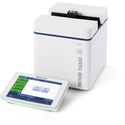Quantification of Iron in Drinking Water Using UV Vis Spectroscopy
According to the Phenanthroline Method
This application note describes a method for determining the amount of iron (II) in drinking water using the phenanthroline method. For more information, download the application note.
Why Is It Important to Determine the Amount of Iron in Drinking Water?
It is important to determine the amount of iron in drinking water because too much iron can be toxic to the body, leading to health problems such as liver damage, joint pain, and fatigue. Therefore, it is necessary to monitor and limit the amount of iron in drinking water to ensure it is safe for consumption.
How Can Iron Be Quantified in Drinking Water Using the Phenanthroline Method?
Iron in drinking water can be quantified using the phenanthroline method, which involves reducing Fe (III) to Fe (II) using hydroxylamine hydrochloride. The Fe (II) ions are then complexed with 1,10-phenanthroline to form an intensive red-orange complex, which can be measured by absorbance at 510 nm. A calibration curve can be plotted using known standards to determine the concentration of unknown samples. This method provides a sensitive and accurate way to determine the amount of iron in drinking water.






